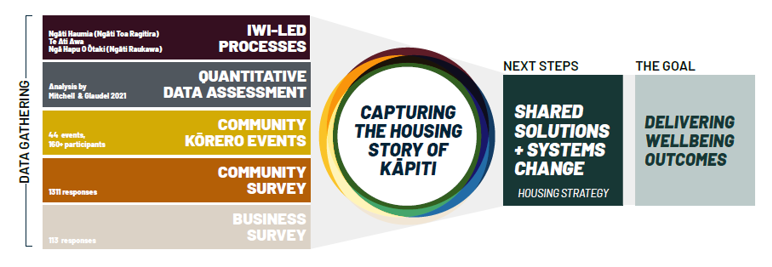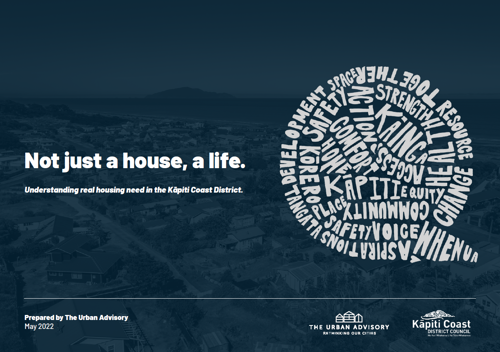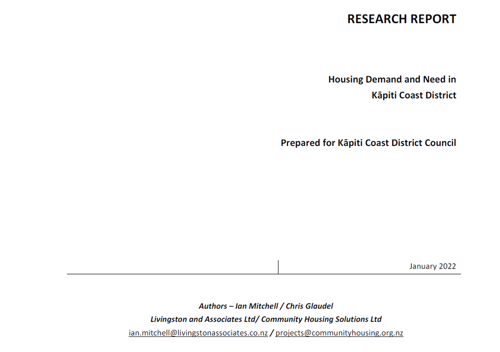Housing needs assessment
With growing concern around the housing and social needs of our district, we've taken an in-depth look at what’s happening, and what’s likely to happen as our district continues to grow. This is one of the first key actions of our housing work programme.
The process
We carried out a five-part process of data gathering designed to capture the housing story of Kāpiti:

We took this assessment a little bit further than most, to make sure we heard from every corner of our community. This assessment was carried out in partnership with iwi, and supported by a number of community organisations and sector stakeholders.
Though late 2021 and early 2022 we had over 1,500 people share their housing stories with us through community kōrero events, our housing survey, and our business survey.
Needs assessment
A needs assessment is a process to identify housing requirements and social outcomes, examine the nature and causes behind the level of housing need in different parts of the community, and set priorities for action.
The assessment reports are a resource for the whole community. The reports give us the robust information base we need for future discussions with Government and will help to enable a coordinated response to address the growing need.
Reports:
Not just a house, a life – Understanding Real Housing Need in the Kāpiti Coast [PDF 22.05 MB], prepared by the Urban Advisory.
What is really at the heart of Kāpiti’s housing issues today? A summary of the vast array of data and findings from the qualitative Housing Needs Assessment to capture, in one place, the housing story of Kāpiti.
Research Report: Housing Demand and Need in Kāpiti District [PDF 4.91 MB], prepared by the Livingston and Associates and Community Housing Aotearoa.
A wide range of data including population, growth predictions, affordability, education and social outcomes and building trends data.
We've also produced an Ōtaki-specific report, Not just a house, a life – understanding housing need specific to Ōtaki [PDF 4.43 MB].
Iwi-led research
As part of this mahi our iwi partners have been conducting research into the housing and social needs in their rohe, ensuring that their voices are shaping decisions around housing and wellbeing as our district grows.
The iwi who were involved in this mahi include:
- Ngāti Raukawa, through the five hapū who constitute Ngā Hapu o Ōtaki.
- Te Ātiawa ki Whakarongotai.
- Ngāti Toa Rangatira and specifically their hapu Ngāti Haumia of Paekākāriki.
Quick guide to findings
The evidence built throughout our needs assessment identifies that housing stress in our district is extensive and beyond solely what is being statistically captured.
Headline findings
- All brackets across the housing continuum are being affected by a housing system that is failing many and causing intergenerational inequality. The impacts are felt in different ways, and not all people are impacted evenly.
- The issues are compounding. Systemic issues will need to be addressed if increasing stress is to be alleviated before it worsens further.
- A lot of hidden stresses and adverse wellbeing effects were revealed in the survey and community kōrero focus group sessions which aren’t as evident in the desktop statistical analysis.
While, by some metrics, Kāpiti is not seen as under as much housing stress as other areas, mostly due to a high base of home ownership rates, the trends between 2001 and 2021 reveal significant issues that will need to be addressed if we’re to avoid some of the extremes being seen in other areas.
For example, between 2001 and 2021:
All signs point to a worsening situation that if left unaddressed will see deprivation rise and the follow-on effects of not having secure housing impact on people’s wellbeing for generations.
The issues in Kāpiti are not as insurmountable as they seem to be in other regions; it is a critical time for Kāpiti to decide what housing future it wants to see.
No matter where one sits on the housing continuum, there are housing concerns that need to be addressed. If the community survey results were spread across the Kāpiti population, the following statements would have been true in 2021:
Some examples of how key groups in our community are being affected in varying ways.
More information in section 4 of the Not just a house, a life report
Because of a lack of options, people are increasingly becoming trapped in unsuitable accommodation, or are being left without access to any accommodation at all.
Survey responses indicated that housing choice in Kāpiti is characterised by a lack of options to suit people at different price points across the housing continuum.
There is a lack of choice of different types of housing, whether to rent or buy.
More information in section three of the Not just a house, a life report
Without options locally, people are forced out of their communities to find somewhere else to live.
This is an issue, because connection to place same through so strongly as a cornerstone of wellbeing.
Many iwi conversations emphasised the community kōrero findings; that tamariki were often the most affected by the displacement being caused by the lack of affordable housing options.
The effect of displacing families was an important intergenerational issue that iwi wanted to prioritise addressing.
More information in section three of the Not just a house, a life report
Lack of secure, affordable housing, lack of choice, and disconnection from community have profound effect on all aspect of a person’s life. This creates stress and desperation, which have a direct impact on overall wellbeing.
This theme speaks to the commentary across the community survey and community kōrero that people’s wellbeing is being negatively impacted as house prices are increasing at a faster rate than household annual incomes and the number of stressed owners and renters is increasing.
More information in section three of the Not just a house, a life report
Addressing housing needs and housing stress requires a coordinated response across our whole housing system. It also requires a shared vision of what success would look like for Kāpiti. This is why we also included key providers in our housing conversations and brought together the various parts of our housing system as part of building our case for change.




